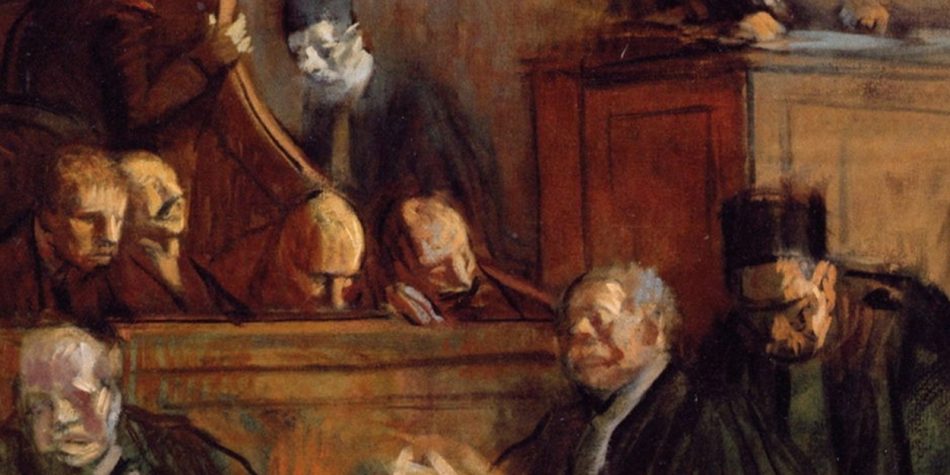The Supreme Court’s much-anticipated decision in Bostock v Clayton County may in fact tell us more about how courts decide what law is than what law says. It may also serve as an unexpected opportunity for judicial conservatives to move away from textualism and reclaim a more inclusive jurisprudential methodology.
For over four decades the legal community has been arguing about first principles for interpreting our laws. In Bostock v Clayton County, a case about LGBTQ rights that the United States Supreme Court will decide this term, the central question involves an interpretation of the federal Civil Rights Act of 1964, which famously bans discrimination based on race, religion, sex, or national origin.
The case is important because it will determine whether discrimination based upon “sexual orientation” is covered by the original prohibition in the statute against discrimination on the basis of “sex.” But the case may actually be more important for the ideas used by the court in how we interpret our laws. The case presents what may well become a textbook example of the application of textualism, and its related concept, originalism, to the interpretation of a landmark statute. Thus from the standpoint of how laws are interpreted, the case is fraught with meaning and symbolism.
That argument will take center stage in a highly ironic way. Judicial liberals will be arguing for textualism (typically the conservative position) and conservatives will be arguing for a much more broadly based contextual understanding (usually the liberal position). From my perspective as a judicial conservative, this is an opportunity to restore textualism to its traditional place in jurisprudence, which could also have the added benefit of reducing the tension between textualism and originalism, something that has received too little attention from conservatives.
To understand the debate, some brief history is necessary.
Textualism, Orginalism, and the Rise of Judicial Activism
For many decades the main complaint of conservatives focused on “judicial activism”—the idea that courts are reading into the language of our laws certain policies that the framers or the legislators did not address. This is typically done by using arguments based upon fairness, equality, and broad readings of the purpose of the language in question. Doing so, conservatives, argued, was to subvert democratic decision-making and turn republican government into rule by the judiciary. This further tends to foreclose the discussion, debate, give and take, and compromise that will address all the related implications of the decision.
To deal with their concerns, many judicial conservatives argued for increased reliance on two particular methods of interpretation: originalism and textualism. Textualism focuses on the literal words being interpreted, their grammatical meaning and their dictionary definition, and largely, although not entirely, ignores other considerations if the meaning of the words is thought to be clear. Originalism focuses on the meaning of the words as they were understood at the time, usually in the sense of how they would have been understood by the public.
Neither method was new, but various champions of these concepts who emphasized their application (particularly when it came to constitutional questions), rose to prominence. Several of them are now on the United States Supreme Court. The late Justice Antonin Scalia was especially associated with textualism, and current Justice Gorsuch has publicly associated himself with this same approach Scalia favored. Justice Thomas is a devoted originalist; and Justice Alito is sympathetic to both originalism and textualism.
On the other hand, the so-called “liberals” on the court are much more in tune with what former Justice William Brennan called “living constitutionalism.” That approach takes the position that many of the provisions of constitutions are intended to have broad and evolving meanings. They are generally in favor of giving preference to judicially developed ideas of fairness, equality, and policy considerations that they believe are appropriate for the current times and circumstances. While not rejecting the ideas of originalism or textualism out of hand, they view the usual application of those concepts as too narrow —insisting that other approaches should be given equal or more weight, depending on the circumstances. In this way, what others might argue is plain, they often find ambiguous. It’s also the case that many of the tools that they would apply are broadly accepted by judicial conservatives and liberals alike, such as looking at the structure and purpose of the law, and related statutes, as well as somewhat more controversial but commonly used methods such as legislative history, or even weighing the consequences of a decision.
The case presents what may well become a textbook example of the application of textualism, and its related concept, originalism, to the interpretation of a landmark statute.
By contrast, originalism emphasizes the long understood idea that a written constitution by definition was constructed by its framers to have fixed meaning. Constitutions provide for a means of amendment, and that process implicitly confirms that what was not amended should be understood as unchanged. The bedrock idea is that a constitution represents the will of the people, freely adopted by both representation and ratification, and not imposed by any other means. Although statutes can be freely changed by the legislature, originalists insist they should have the meaning that they had when enacted.
This straightforward concept is eroded, however, by two hundred years of change, some obvious and some, as the great historian Gibbon would have said “insensible”—happening so gradually and imperceptibly that most hardly even noticed it. Major events like the Civil War and the amendments to the Constitution that it generated, introduced broadened concepts of due process and equal protection to the constitutional text and our way of thinking about laws more generally. The massive economic growth of the country also generated different ways of thinking about commerce, and how the state regulates behavior through a huge administrative process.
Together with these developments, a growing body of legal academics began to emphasize various sophisticated issues, such as the potential elasticity of some of the language of law, arguing that standards such as “cruel and unusual punishment” were intended to have an evolving meaning, not one fixed for all time unless amended. Finally, as judges and scholars have noted for over 150 years, a system where courts determine the meaning of laws and statutes creates its own evolving body of precedent. This is what the great Michigan judge and scholar Thomas Cooley called “judicial legislation,” and later the highly influential justice of the New York Court of Appeals, Benjamin Cardozo, explained as the “judicial process,”—namely the inevitability of changes to the understanding of the meaning of constitutions and laws as courts come to interpret them.
Judicial liberals then made the case that what might otherwise be considered the unfortunate but inevitable limitations implicit in written laws and constitutions was a positive thing. As they argued, since change will happen, and no written law is perfectly clear in every instance, let alone over long periods of time, we can think of our constitution as a “living” document, able to accommodate new circumstances and differing cultural assumptions. The problem with this point of view (as judicial conservatives have argued with some success over the last several decades) is that “living constitutionalism” means that the courts become the ultimate decision makers with respect to the most fundamental cultural and political issues of the day, such as abortion. Hence the concerns about “judicial activism.”
Originalists argue that living constitutionalism throws out the baby with the bathwater. It is undeniable that there are often problems with determining what a constitution or law originally meant, and how that meaning ought to be applied in current circumstances that could not have been anticipated many years ago. But just because something is difficult does not mean that it shouldn’t be attempted. The originalist argues that we ought to do our best to search out the answer to the question of the original meaning of a constitution or a statute as the first step in any judicial inquiry, because it is fundamental to resolving the issue of a law’s meaning. Textualism is related, but a much more limited idea. Again, it springs from a traditional legal concept usually called “plain meaning.” The essence of this idea is this: if the grammar, syntax, and words make it obvious and clear what the language of a legal text was intended to convey, that is the interpretation that it should be given, and other potential sources of meaning should be ignored, because, after all, it is what the written document says that is the best evidence of what the voters agreed upon.
The Challenge of Textualism
The first part of this concept seems difficult to object to: if the words are clear, the interpretation should follow. But the problem is typically how you tell if the meaning is clear from the words used? Words can change their meaning over time. And there is the problem of context. We all interpret language based on context. In the case of law, that usually means the apparent purpose of the provision and the related terms. So, there can be a problem if the language seems clear but the equally clear purpose of the statute seems totally inconsistent with it.
Similarly, what if the history of the statute seems to show that there was no discussion of the issues that the case now has brought into the open? Often there is a public record of the problem that the legislature was trying to address. Sometimes this history indicates that the law was intended to address a particular problem; sometimes the contrary is true. Should this matter? Most courts have used legislative history (such as the proceedings of the legislature, versions of a statute that were rejected, and so forth) to help determine meaning. Justice Scalia and some other conservatives have been skeptical of legislative history because it is susceptible to abuse, but, of course, what tool can’t be misused?
While these questions are most often talked about in the context of constitutional law, these same concerns apply in interpreting statutes. In many ways, statutory interpretation should be easier because there are special problems in understanding constitutions that are less problematic with statutes. For example, constitutions call for popular ratification, so understanding the meaning that the public felt they were voting for can be more complex than discerning what a legislature was adopting. Similarly, fully understanding the background and purpose of provisions adopted in 1787 will generally have problems that a statute adopted in the 1960’s will not.
Courts traditionally spoke of legislative intent in interpreting statutes. That concept has been challenged because the legislature is simply an aggregation of legislators, not a single mind, and each legislator can vote for something for entirely different reasons (such as in return for favorable action on a totally unrelated bill). Nonetheless, despite such sophisticated critiques, it is not unreasonable to presume that regardless of the reason, that there are common understandings of what legislation is intended to do and achieve.
Bostock v Clayton County (which has been paired with another case, R.G. & G.R. Harris Funeral Homes V EEOC) requires the court to interpret a 1964 statute. While 55 years separate us from the date of that enactment, its passage is within the living memory of most of the current members of the Supreme Court—if you were in your teens or later when the law was passed, and you had any interest in politics at all, you knew about the Civil Rights Act of 1964. It was the culmination of both the Civil Rights Revolution of the 50’s and the 60’s and was also portrayed as a memorial to President Kennedy, who had been assassinated the year before. And passage of the Act was a tightly contested decision.
The circumstances were remarkable, starting with the accident of a southern president, Lyndon Johnson, who was put in place by President Kennedy’s assasination. With the support of Republicans led by Everett Dirkson, and Northern Democrats, led by Hubert Humphrey, Johnson was able to maneuver passage through the senate and overcome what had been an unbreakable filibuster. It was a triumph of republican democracy; despite the fears of President Johnson and others that the Act would be desperately resisted, especially in the South, the distinguished historian Robert Dallek tells us in his book “Flawed Giant: Lyndon Johnson and his times 1961-1963,”—“Because the civil rights bill was an act of Congress rather than ‘judge or court made law [Senator Richard] Russell expected the South to accept the outcome with little trouble. It did” (p.121). Perhaps this too is a lesson for the Court in approaching Bostock.
Textualism is merely one tool in the judicial toolbox; it is a useful hammer when one is dealing with a nail, but it will not replace a plane when dealing with the rough edges of statutory interpretation.
The fundamental question that interpretive guides such as textualism and originalism might help us answer is whether the democratic process, through the legislation of the 1964 Civil Rights Act, encompassed the question of discrimination on the basis of sexual orientation. To answer that question, using an originalist approach, there are many contextual questions that we can ask, such as whether the issue of discrimination on the basis of sexual orientation was discussed by the legislature and was reflected in the public understanding of the legislation when it was being passed?
A group of legal historians provided an Amicus brief in Bostock which provides some information on the general subject. These legal historians show that issues about homosexuality and even transgenderism were not unknown, and had some cultural currency. But the problem with their otherwise helpful survey is that it avoids answering the central question: did the legislature take note of the issues and is there evidence that this legislation was publicly understood to address them? The answer to both questions seems to be “no.”
The historians do not present us with evidence that they were given consideration in the passage of the Act, other than to argue that the word “sex” might have been seen as sufficiently broad to involve gay and lesbian issues. This is a a very slender reed; that it is conceivable that sex might have been so broadly defined does not provide us with evidence that this was the meaning that was understood by either the legislature or the public which followed the passage of the Act. The direction and implications of much more prominent issues still remained undetermined at the time of the Act’s passage. In James T. Patterson’s “Grand Expectations: The United States, 1945-1974,” a book of nearly 800 pages that does not slight details about the period, he summarizes events of the early sixties that extend well beyond the civil rights struggle of black Americans, including the beginnings of environmentalism, student radicalism, the “counterculture,” feminism, and challenges to sexual mores. Yet he concludes “These and other developments hardly added up to a coherent movement, or even a clearly visible pattern” (p. 446).
Only with hindsight can these events of the early 60’s be seen as the beginning of a movement. We ought not to assume that legislators in 1964, who were primarily focused on addressing the racial issues that had divided generations, had a preternatural understanding of, and had decided to address, cultural movements that remain contentious 50 years later. And while counterfactual questions are usually of limited value, is it likely that if the legislature believed that gay and transgender rights were part of the package of civil rights at issue, that the Act would have passed?
This is not, however, the end of the historical inquiry. The Act was amended in 1991, addressing sex as a motivating force in employment discrimination. However, at the same time, the legislature rejected language that would expressly include “sexual orientation.” In light of that choice, do we now read “sex” to mean “sexual orientation” when Congress rejected explicitly doing so? The conservative view would seem to be that the broader reading of sex to implicitly include sexual orientation in the face of an express decision by the legislature to avoid making that meaning clear would seem to be counter to an originalist perspective. In other words, to read a reference to prohibit gay or transgender discrimination on the basis of “sex” that might be implicit in a 2020 reference to sex, would be highly anachronistic. If the democratic process has failed to yield a clarification of this kind, what basis is there for a court to read the words in that fashion?
Here is where the textualist argument is being made in pursuit of the liberal reading. Yale Law professor, William Eskridge, an expert on statutory construction who co-taught with Justice Scalia at Georgetown law, calls this case “Textualism’s moment of truth.” In his view, the argument that discrimination based on sexual orientation is a word game that does not answer the plain meaning argument. He makes two types of arguments.
First he analogizes to the court’s decisions with respect to race. Discrimination on the basis of race has been broadly construed under the Act, he argues. Why then a more narrow view of sex than race? The response is that in those cases the textualist issue does not seem to be the same; when there was a clear focus on race and the implications of racial discrimination in the passage of the Act, we do not have the same potential disjunction that exists in this situation between reasonably anticipated consequences and those that result from much changed understandings. That is, it was reasonably clear that there would be broad implications for any racially based distinction due to the passage of the Act. But in a world where homosexual acts remained criminal in most states, gay marriage was not allowed, and transgenderism limited to a few unusual cases, would a legislator reasonably expect that the word sex would be so broadly construed, even in 1991?
His second argument uses a Scalia decision regarding male on male sexual harassment as covered by Title VII to refute a version of the argument made here: that this was too far beyond the “paradigm case” of sexual harassment. Scalia found that “statutory prohibitions often go beyond the principal evil to cover reasonably comparable evils.” Of course, this leaves us with the question of whether Congress might have anticipated that this type of discrimination was a reasonably comparable evil in 1964 or even 1991. To answer such a question takes us back to an originalist focus.
If this is textualism’s moment of truth, it may be a good thing for judicial conservatives to focus on the limitations of the concept. Textualism is merely one tool in the judicial toolbox; it is a useful hammer when one is dealing with a nail, but it will not replace a plane when dealing with the rough edges of statutory interpretation. Furthermore, judicial conservatives would do well to remember that as this case demonstrates, there is nothing inherently conservative about textualism. While its current incarnation developed as a response to find almost everything sufficiently ambiguous as to allow elastic interpretations of language, it seems to me that it moves from one extreme to the other.
The problem with textualism, which seems to have been better understood in its traditional guise as the plain meaning doctrine, is that it has severely limited value. One judge’s plain meaning tends to be another’s ambiguous language. Because a claim of textualism tends to include the statement that it is neither necessary nor proper to look at other evidence of a statute’s meaning, it is particularly susceptible to claims of bad faith. In other words, how can you say that any reasonable person would agree that the language plainly means what you think, when I and other people whom I consider at least as reasonable a you think it means something different? Such arguments poison our legal discourse.
It is vastly more persuasive, and in keeping with the spirit of honest inquiry, to look at the full range of argument about the meaning of a legislative text, including purpose, structure, the relationship to other existing laws, legislative history, and public debate, and the commonly-accepted meaning of the words used at the time. If all of these concerns point in the same direction, then it is vastly more likely that the meaning of the words is plain. On the other hand, if several concerns point toward a different interpretation, how persuasive is it to say “Well the words of the text seem obvious to me,” for the corollary is that if you disagree you are either a liar or a simpleton. As the academics might say, all you have done is shown your identification with the assumptions of one “interpretative community” which are at odds with those of another; for example, to the conservative community the words seem plain but to the liberal community they seem ambiguous, or vice versa. It is in the process of ferreting out these different assumptions and seeking to identify and develop the most persuasive arguments in the face of what is often conflicting evidence that we do the most justice to the judicial task.
One does not need to succumb to the seductions of postmodernism to concede that the past 55 years have also given us deeper insights into the limitations of language. Ironically enough, it is one strand of postmodernism that has given us the notion that “there is nothing outside the text”—it could be the textualist battle cry! And yet our common experience tells us that this is a vast oversimplification. All parents know that what they believe are the most plain declarative statements to a child often result in a colloquy that concludes: “I don’t care what I said; you know what I mean!”
Context is critical to understanding. Common assumptions are essential building blocks for clear communication. Despite various shortcomings, it is for these types of reasons that the intent of the legislature was always such an important judicial notion, for it called for contextualized questions to be asked and answered, and assumed a common point of reference. Similarly, despite the misgivings of Justice Scalia about legislative history, which seem to have sprung from a not-inappropriately jaundiced view of how it was written by the self-interested, when stripped of its barnacles, such history can be very useful in helping us to understand what problems were and were not being considered by the legislature, and what policy outcomes were being sought.
If you will excuse the expression, it also seems plain to me that the type of textualism at issue here is in tension with originalism. The originalist effort is deeply contextual. It sifts through all of the evidence to attempt to fully and faithfully reconstruct the most common public understanding at the time of enactment. All the tools in the judicial toolbox of interpretation are called upon to provide us with what seems the most persuasive understanding of the law. Reading the language of the text is surely the first step in the process, but it is hardly the only step necessary and it surely is not sufficient.
The fundamental question that interpretive guides such as textualism and originalism are to help us answer is whether the democratic process has resulted in a policy that guides us to a particular outcome. In this case, that is through examining the legislation of the 1964 Civil Rights Act to determine whether it encompassed the question of discrimination on the basis of sexual orientation. To answer that question, there are many contextual questions that we can ask, such as whether the issue of discrimination on the basis of sexual orientation was discussed by the legislature and was reflected in the public understanding of the legislation when it was being passed? As noted, when reviewing the effort of the legal historians who argue for this interpretation, it seems reasonable to conclude that their effort came up short of the mark.
This is also the point of the Liberty Institute, another amicus. The Institute’s lawyers use the colorful maxim that “Congress does not hide elephants in mouseholes,” meaning that the court should not find that Congress created a far-reaching, culturally significant policy based upon a small bit of language the potential application for which could not have been appreciated at the time.
For judicial conservatives, a positive bottom-line result from Bostock ought to be a sober reconsideration of textualism.
One of the most persuasive arguments that the Institute makes is that the implications of the policy that supposedly stems from this textual argument necessarily result in important questions of religious liberty that Congress would have wanted to consider based upon how it has responded to similar issues in the past. Not only does a judicial interpretation of a statute creating broad policy that was outside the reasonable expectations of the time undermine democratic decision-making in general, but it also frustrates the ability of the legislature to engage in the compromise and give and take necessary to balance various competing policies and rights. And, as shown by the history of the Civil Rights Act itself, public acceptance of change that comes from an open and customary political process in Congress results in much higher likelihood of public acceptance of the outcome.
For judicial conservatives, a positive bottom-line result from Bostock ought to be a sober reconsideration of textualism. It is a limited tool that is far too susceptible to abuse when taken to its logical extreme, undermining rather than preserving the democratic process and orderly and transparent legislative decision-making, and also hindering a critical judicial task, which is to spell out all of the relevant arguments, pro and con, for a legal interpretation in order to make the most persuasive case possible for what the court concludes is the proper outcome. For judicial conservatives to retake the moral high ground when faced with vague claims of equity and fairness, they need to embrace a more inclusive approach that emphasizes a comprehensive approach to judicial decision-making that will persuade the persuadable that their commitment is to a rule of law, not a preferred outcome.

















